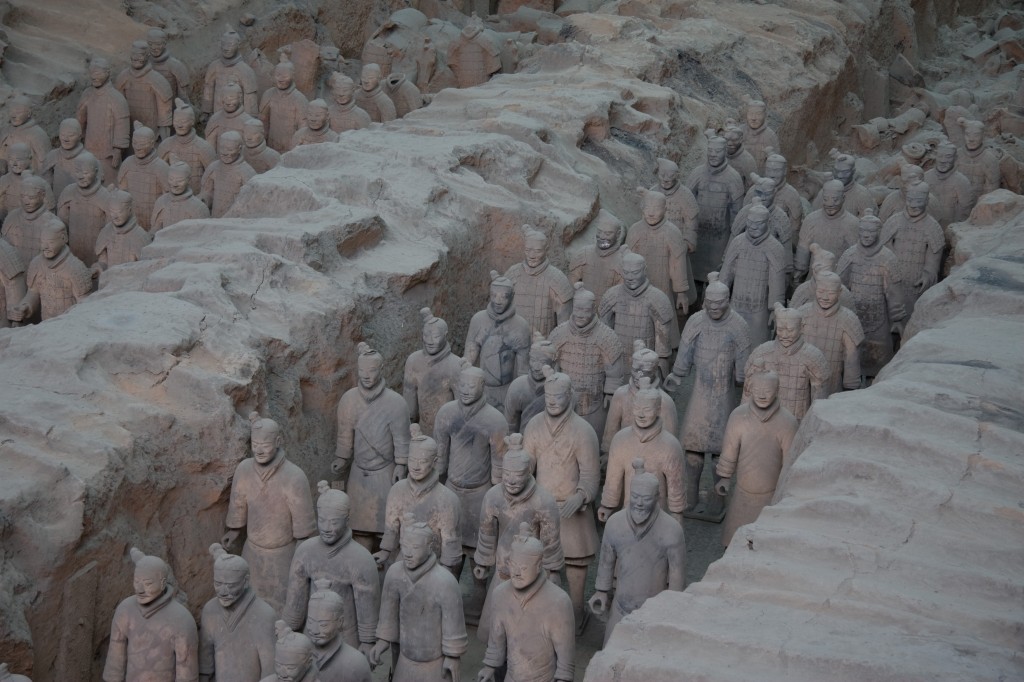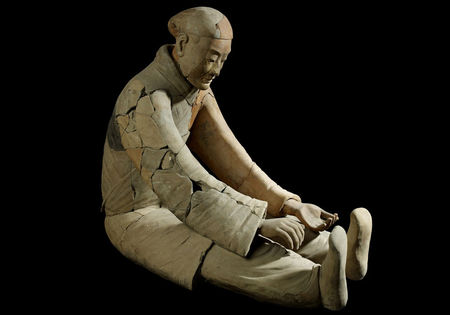Did the Greeks Build the Terracotta Army? March 19, 2014
Author: Beach Combing | in : Ancient , trackbackWe’ve fluttered before around the interesting work of Lukas Nickel (see link at bottom of this page), alleging contacts between Greece and China in the early centuries B.C. In a recent article (‘The First Emperor and sculpture in China’) in the Bulletin of the School of Oriental and African Studies LN suggests that there was likely a connection between the famous ceramic army of the first Chinese Empire, the boorish Quin Shi Huang (obit 210 B.C.), and the Greek tradition of sculpture. So what is the proof that LN has dug up? Are there Greek fingerprints on the fired figurines? Is there the odd Aphrodite hiding out down below? Are there perhaps Macedonian tools in the foundries? Well, not a bit of it… There is no smoking gun. LN has produced one of those Sherlockian ‘when you have eliminated the impossible, whatever remains, however improbable, must be the truth’. These include the following propositions. There is no Chinese tradition of realistic sculpture to speak of before the ceramic army: yet the ceramic army and particularly some ‘acrobatic’ figures are born, so to say, ‘fully formed from the head of Zeus’. Someone, he reasons, must have given this tradition to the Chinese and in the third century B.C we have both a well established Greek tradition of realistic sculpture and we also have recent Greek penetration of Asia under Alexander. For me this is suggestive but nothing more. However, LN adds another consideration that I found both surprising and persuasive, namely that there was no proof for a tradition of realistic sculpture anywhere else in Asia or for that matter Europe.
There is one easy way to attack this thesis and if China’s national news agency has not already done so along these lines Beach will eat his Comb. First, it is not true to say that there is no tradition of Chinese sculpture. In fact, LN gives several examples from the ninth century B.C. onwards. The tradition is minor. There are not that many instances. But is that because perhaps a great deal of sculpture was in perishable materials: particularly wood? (Memories of extraordinary arguments about late Roman mosaics being replaced by perishable Persian rugs.) LN has an answer here. For him some of the figures associated with the terracotta army show up surprising features. He is referring particularly to the so-called ‘acrobats’ placed there. These go beyond the sometimes shoddy craftsmanship of the warriors and show muscles, bones and more body details. Here LN is emphatic, the only other place in Euroasia where people are playing around with these details were Greece and the Chinese could not have arrived at these details themselves in a single generation. Given the hints (again suggestive rather than conclusive) for contact between Greeks and the Chinese in this period, covered in an earlier post, it is only right to open a file entitled: ‘Early Greek-Chinese Contact (Sculpture)’. In short, an exciting thesis that will be much discussed in the next years. Other thoughts on Chinese-Greek contacts: drbeachcombing AT yahoo DOT com
Finish with this beautiful and very naturalistic sculpture from the tomb: a seated musician. Look at the details of the hands and feet. Note this image is not used by LN.
20 March 2014: MC writes, putting this all in context, ‘The Greeks are universally recognized to have influenced Chinese arts, but not directly. The Seleucid first and the so called Greco-Bactrian Kingdom (250-125BC)brought Greek ideas and influence to Central Asia. This influence is well attested by such intriguing works as the Milindapanha, a dialogue in pure Platonic style between the Greek general (later king) Menander and a Buddhist monk called Nagasena. However the most tangible and lasting legacies of Greek influence in Central Asia are work of arts. A sanctuary dedicated to the god Vaxshu in Takht-i Sangin (Afghanistan) was long identified with a Greek temple built by Alexander’s troops, because it looked just like one. Vajrapani, the guide and protector of the Buddha, could be mistaken for Herakles, being represented as a musclebound man armed with a club and wrapped in a lion skin. The theme of Zeus taking the form of an eagle to kidnap Ganymede passed into Buddhist art, with a mighty bodhisattva falling in love with a married woman and taking the form of the legendary bird Garuda to carry her off. Examples abound and a lifetime could be dedicated to study them. Sogdiana, part of the Greco-Bactrian kingdom, has been an incredible melting pot since at very least the sixth century BC. It was from here that Buddhism got into China first. It is widely suspected it was here that some religious belief typical of Iranic people started their march westward and, ultimately, into the Middle East. The same applies to art. Greek art was amalgamated with Indian art: the former brought by the ruling class from the West and the latter brought by monks, pilgrims and holy men from the South. Art traveled East, toward China, through the Silk Road, a process that accelerated once the Kushans (know to Han Chinese as Yueh-Chih) overthrew the last Greco-Bactrian rulers around 130BC. The Kushans’ origins are far from clear, but the present theory is they were not an ethnic group as we intend it: they were probably a federation of Indo-European peoples. The Kushans were fantastic amalgamators. Their symbol was the Greek goddess Nike, their coins brought images of a bewildering array of deities: Iranian, Indic, Buddhist etc. Their first three rulers (father, son and grandson) favored three different religions. The last of these, Kanishka II, called a Buddhist council in Kashmir in which it was decided to rewrite religious texts in high literary Sanskrit, the turning point in Buddhist literary canon. Their form of art, the culmination of the amalgamation of Indic and Greek art, with influences from Persia, was called the Gandhara Synthesis. China on the East had already absorbed and reelaborated the influences coming from the West, but the Gandhara Synthesis proved a crucial and lasting influence. Art continued to travel on the Silk Road: a painting found at Miran, in the Tarim Basin, was the work of an artist named Titus, who could have been a Roman artist who somehow found his way to China’s doorstep.Hope this didn’t bore you to tears and could extrapolate the fact that there’s absolutely nothing strange with the idea Chinese art was heavily influenced by the Greeks.’ thanks MC!




